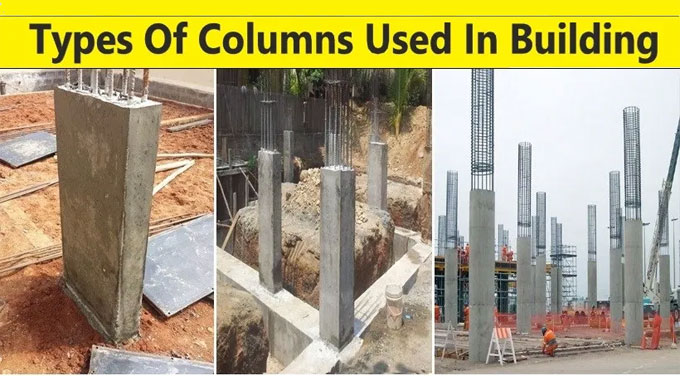
Different types of columns used in construction
Column is a vertical part which moves loads of a structure from beam and slab to the foundation. The powerful depth of a column surpasses multiple times the horizontal measurement. By and large, columns convey axial loads in compression. Columns are significant segments of a structure. Disappointment of columns brings about the breakdown of structure.
In this article, We will talk about various types of columns utilized in building and/or structures.
Types Of Columns: There are distinctive column types utilized in structures. The types of Columns can be ordered relying on a few conditions, which are:
1. Shape
2. Reinforcement
3. Types Of Loading
4. Slimness Ratio
5. Materials
Types Of Columns Based On Shape
Square Or Rectangular Column: Square or rectangular columns are for the most part utilized in building development. These types of columns are monetarily acceptable and simple to develop due to it's simple covering and reinforcement position.
Circular Column: Circular columns are for the most part utilized in heaping and rise of the structures for stylish purposes. In a circular column, in excess of 4 steel bars are utilized as reinforcement and its twisting opposition is normally higher than square or rectangular column. Other than structures, circular columns are likewise utilized as extension columns because of good redirection obstruction.
L Type Column: L type columns are utilized in limit divider development and in the turning of metro rail or in flyover development.
T Type Column: T type column has the same component as square/rectangular column and for the most part utilized in connect and holding divider development.
Y Type Column: These types of columns are generally utilized in extension and flyover development.
Some different types:
a. Hexagonal column
b. Octagonal column
In view of The Type Of Reinforcement
Tied Column: These columns have shut horizontal ties dispersed around and consistently over the column. The dividing of the ties is constrained in that they should be sufficiently close to forestall barrelling disappointment among them, and far enough separated that they don't meddle with the setting of the concrete. On the off chance that ties are divided excessively far separated, the column will encounter shear disappointment and barrelling in the middle of ties.
Spiral Column: At the point when circular columns are fortified with intently and consistently dispersed spiral reinforcement, they are known as spiral columns. The spiral demonstrations to offer help the transverse way and keep the column from barrelling. Spirally strengthened columns for the most part comprise of 6 bars as longitudinal reinforcement.
Composite Column: These columns consist of basic steel or cast iron columns encased with concrete, fortified with longitudinal just as spiral reinforcement. Composite columns are generally utilized in support structures to stay away from the erosion of steel.
Column Types Based On The Type Of Loading
Axially Loaded Column: At the point when the resultant of the load agrees with the centroid of the cross-area of a column, it is called axially loaded or concentrically loaded column. These types of columns once in a while utilized in development.
Eccentrically Loaded Column: At the point when the resultant of the load doesn't agree with the centroid of the cross-segment of a column, it is called axially loaded or Eccentrically loaded column. There are two types of them:
1. Uniaxially Eccentrically Loaded Column: At the point when the whimsical load follows up on either X-pivot or Y hub is called a uniaxially erratically loaded column.
2. Biaxially Eccentrically loaded column: At the point when the flighty load doesn't follow up on either X-hub or Y-pivot it is called a biaxially or whimsically loaded column.
Column Types Based On Slenderness Ratio
Short Column: At the point when the ratio of the compelling length of the column to its least horizontal measurement is under 12, it is called a short column. In short, mechanical disappointment primarily happens because of shearing.
Long Column: At the point when the ratio of the viable length of the column to its least parallel measurement surpasses 12 the column is considered a long column. Such columns are obligated to flop due to clasping. Long columns are more fragile contrasted with short columns of same cross-sectional territory and not by and large liked.
a. Strengthened concrete column
b. Steel column
c. Timber column
d. Stone Column
e. Brick column


